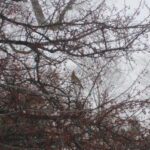red cardinal bird
I have been trying since spring to get this picture. These little guys must have a special sense that tells them to disappear the second a camera is pointed at them.
Winter is harsh on the little feathered friends, and food sources are scarce. If you provide for them in the winter months, they will be more likely to make your garden their home. Even if you might have planted lots of flowers that provide the birds with food (dill, sunflowers, and cone flowers are a few that come to mind), make sure to give them consistent and substantial food during the cold months (adding suet to their diets in winter will help them overcome the brutal cold, they burn a lot of calories trying to keep warm.)
Remember also that birds need water all year long, so if there is not a lot of precipitation provide some fresh water every day in a shallow bowl or a bird bath. The water and food sources need to be protected from predators and close to a large tree or thicket, so that the birds feel safe that they have a place to hide if attacked.
I’m sure you must have seen “Certified Wildlife Habitat” yard signs, for example my children’s school has one. If you would like to certify your wildlife garden (clicking on this link will take you directly to the application process and requirements), here is what you need to provide:
- Food – Provide three of the following types of food: Seeds from a plant • Berries • Nectar • Foliage/Twigs • Nuts • Fruits • Sap • Pollen • Suet • Bird Feeder • Squirrel Feeder • Hummingbird Feeder • Butterfly Feeder
- Water – Your garden must have at least one source of clean water for birds to drink and bathe: Birdbath • Lake • Stream • Seasonal Pool • Ocean • Water Garden/Pond • River • Butterfly Puddling Area • Rain Garden • Spring
- Hiding places – At least two places to find shelter from predators and harsh weather: Wooded Area • Bramble Patch • Ground Cover • Rock Pile or Wall • Cave • Roosting Box • Dense Shrubs or Thicket • Evergreens • Brush or Log Pile • Burrow • Meadow or Prairie • Water Garden or Pond
- Places to nest – Provide at least two nesting places: Mature Trees • Meadow or Prairie • Nesting Box • Wetland • Cave • Host Plants for Caterpillars • Dead Trees or Snags • Dense Shrubs or a Thicket • Water Garden or Pond • Burrow
- Sustainable Gardening – Engage in at least two of the sustainable gardening techniques below:
Conserve soil and water: Riparian Buffer • Capture Rain Water from Roof • Xeriscape (water-wise landscaping) • Drip or Soaker Hose for Irrigation • Limit Water Use • Reduce Erosion (i.e. ground cover, terraces) • Use Mulch • Rain Garden
Control Exotic Species: Practice Integrated Pest Management • Remove Non-Native Plants and Animals • Use Native Plants • Reduce Lawn Areas
Organic Practices: Eliminate Chemical Pesticides • Eliminate Chemical Fertilizers • Compost
Please check out the National Wildlife Federation website to find out how to garden for wildlife and a lot of other important information about preserving wildlife habitat.




 Previous Post
Previous Post Next Post
Next Post




